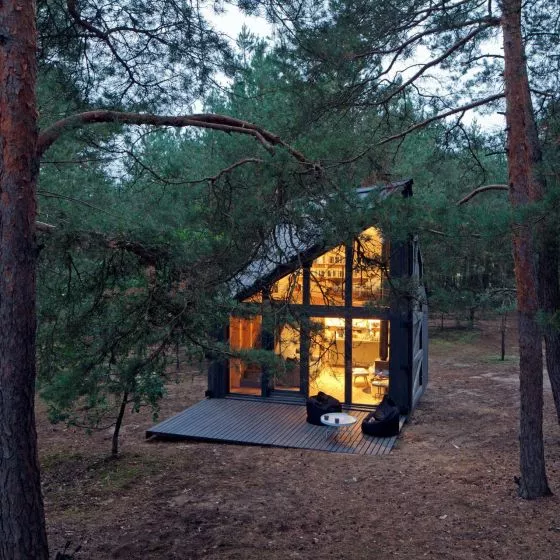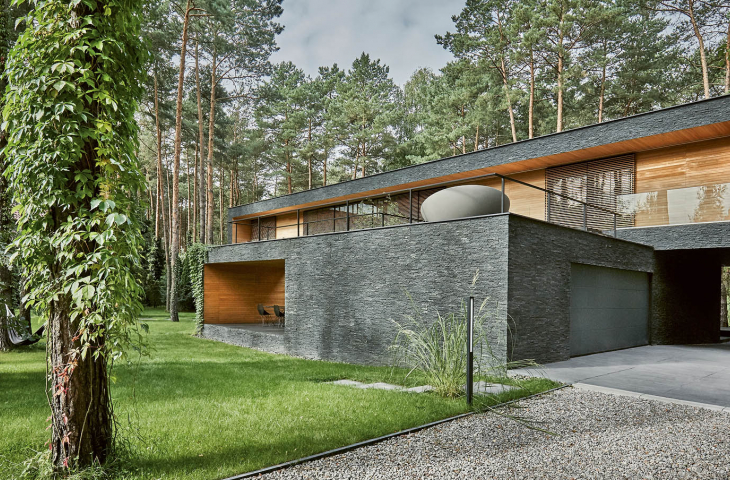Clients
Catherine: What do clients expect in general? Do they come with ready-made ideas and a vision for you to give shape to, or do they rather expect a proposal?
Rafal: There are several types of clients. There are those who come with a ready-made projection and ready-made photos of the building. We then say, "Great, but let's talk about the function of the building, not the shape, because we are not interested in the shape at all at this point." Such a client, who shows us what he wants, gets something completely different in the final version. Something that surprises him, but it turns out that this very form is for him.
Anna: I'll just interject that, above all, we try to listen to our customers. Indeed, the most difficult client is the one who says he has gone over everything and knows how it should look, and would like us to just patch it together. This is the longest road, because you have to gently let them know from the very beginning that it can't be translated that way, that we won't do the same building the client came to us with, that this can be our base or starting point, that the client likes, for example, such materials or a kitchen window for the entryway, and we will try to offer something of our own tailored to the client's expectations. Then we try to get customers to focus on function - how they live, how they move around the house, what they care about. That's why it often happens that a lump comes out completely different from the one they came with. In the end, they are very satisfied. It turns out that functionally everything works as they wished, material-wise they also got what they liked, and the building came out better than the one they came with.
We usually get people who simply want to realize the house of their dreams with us. We focus on the function, and they leave us free hand when it comes to the massing. The result is also determined by other factors - the local plan, sometimes we have to adjust the width of the elevation, for example, or the conditions of the plot, as in the case of the Forest House, which had to fit into the outline of previous buildings.
We try, if possible, to make the architecture fit into the context of nature. When there are trees, so that the material is not so eye-popping that you get the impression that it's about to pop out of the plot, but should blend in with the trees.
"We try, if there is a possibility, to make the architecture fit in with the context of nature."
Anna Paszkowska-Grudziąż
Photo: Bartek Zaranek © 81.WAW.PL
Katarzyna: You can find a common denominator in the individual house projects. What are you inspired by?
Anna: Maybe I will start from the common denominators. We have certain principles that we try to smuggle into the designs, such as glazing at the entrance or opening up upon entering the house. We usually have a hallway overlooking the garden or an interior patio.
Rafal: We often use wood on the facade and are not afraid to use new and unusual materials, such as sauna board on the facade, mirror boards, fieldstone and many others. Each project is a new challenge and a separate story.
Anna: We try to relate to nature. Wood is warm and nice, clients like this material even though they are afraid of it. Although concrete looks good, wood is more pleasant in an apartment. The warmth in the form of wood is kind of intuitive. We always try to make sure our designs are supported by an idea, it's good when we have a starting point. When clients come to us, we show a prepared logo that carries a story. Now we are doing a house that is being built on the shape of the CPN logo.
Rafal: That's because Ryszard Bojar, one of the co-creators of the CPN logo, had his home and studio on this plot of land. For us it was amazing information, at first it overwhelmed us, but it gave us an idea. In the projection we have the logo, but it's hard to read it from the block. An amazing thing, because the new building was connected to the history of the place in this way. The investor also liked the idea and accepted it right away.
Anna: Inspirations come in many different ways. Once we went with clients to a plot of land and just happened to see a viper. The owner got scared. We started talking about it, completely spontaneously. And we came to the conclusion that due to the restrictions of the local plan as to the width of the plot, the house should be precisely in the shape of a creeping snake, that is, the letter "S" or "Z". Investors like this, they identify with the story and thus know that the project is tailored for them.
Rafal: In this way it is very easy to defend even a controversial idea. Without the context it would be something, let's say, bold, but with the whole story it is much easier to convince people of something that is unusual.
View from the main entrance of the house; loosely scattered panels lead from the gate to the front door
Photo: Bartek Zaranek © 81.WAW.PL
Catherine: Each house has a name. This alone shows their individuality.
Anna: Now we are starting to play with names even more. We are currently designing an estate in Wilanów, which we have named Villa Nów. It's an elegant, spread-out house, it's not bold or controversial, rather one that appeals to many people, pleasing to the eye.
Rafal: With an individual name we emphasize our idea of a house. For us, this is important. It's not project number 02 or 03; the name is associated with the building. The house personalizes itself. The Field House is located in a field, it has walls made of field stone. The Forest House, because slate, tree bark, forest. Triangle House itself is almost triangle-shaped, the plot was very unusual, just in this shape, triangles appeared on the outside. We infected clients with the story of triangles.
Anna: They approached us with the dilemma of whether anything could be built on this triangular plot. We said that the house doesn't have to be on a square or rectangular plan, that it can be a triangle, and still the rooms will be set up. The slanted corners can be used for technical rooms or for larger, open spaces like the living room, while the bedroom can be rectangular. We showed them the project, they bought a plot and the house is already standing.
I think it's worth listening to people. Even the first conversations give a lot of information. We get to know each other, the more meetings we have, the more people open up and say things that can give us an idea. When a plot of land has potential, as in the case of the Forest House or the Field House, it's easier to do something interesting on it, whether there is history or not. On the other hand, when you have a plot of one thousand or one thousand five hundred square meters and typical buildings all around, the question is what to do here. Especially in such a situation, discussions are important. Let me give another example: the clients for whom we designed a house, we will now design a small office building. We already know each other, so we talk on a slightly different footing. Laughing, they told us that although people come to them for materials, they actually all stop by for coffee, because they make the best one in the area. And that it's so homey at their place. That's what stayed in our minds: that it's homely and that there's that coffee. So when creating the office building, we started thinking about making a scaled-down house in the form of an office building, so that at the first moment it would give an association with home, with something warm. We also wanted to offer interiors that create a homey atmosphere, so that people wouldn't feel like they were entering a store or a cool office space, but just like themselves.
Covered terrace on the forest side with direct access from the living room
Photo: Bartek Zaranek © 81.WAW.PL






























































